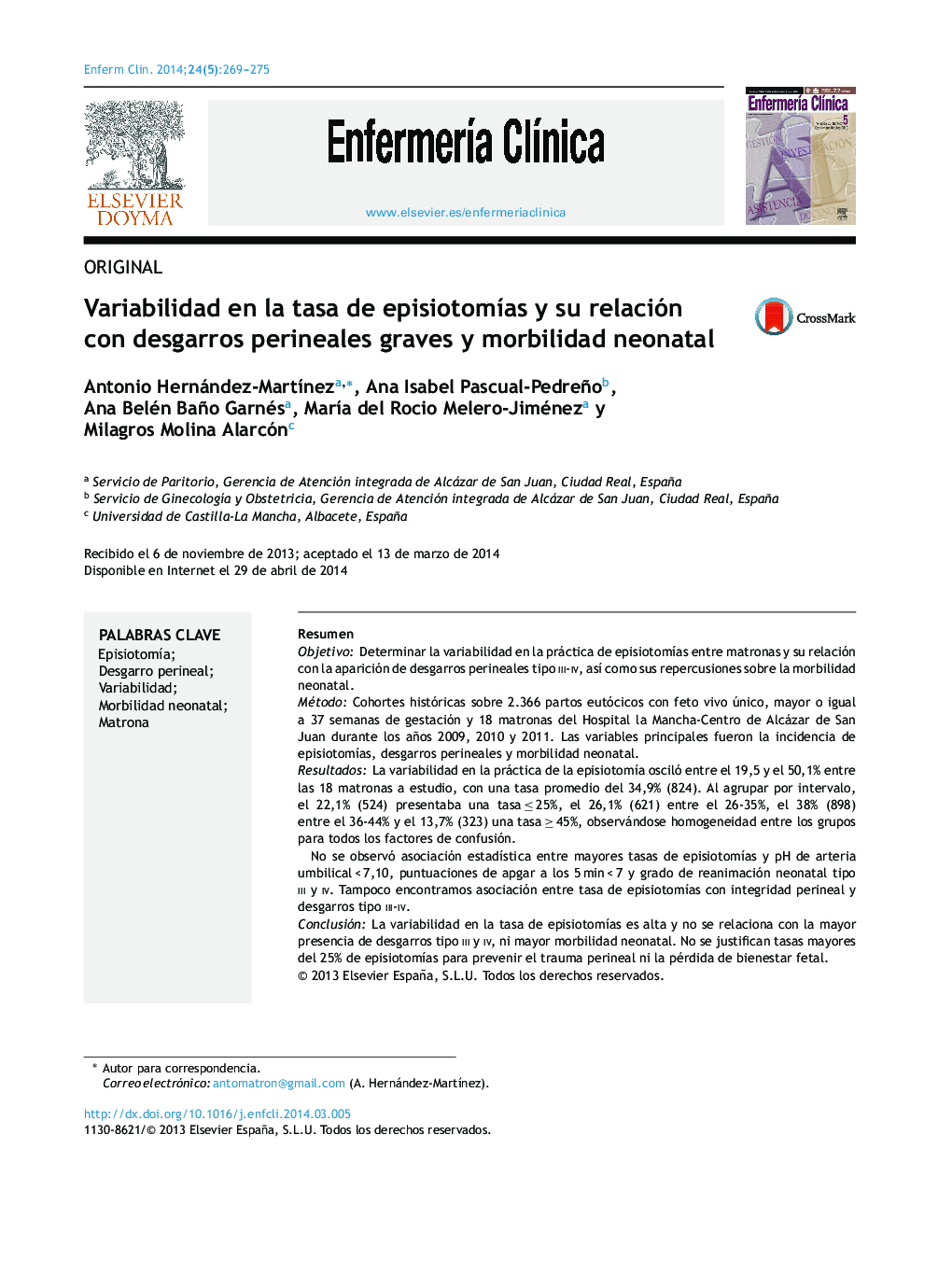| کد مقاله | کد نشریه | سال انتشار | مقاله انگلیسی | نسخه تمام متن |
|---|---|---|---|---|
| 2647040 | 1138982 | 2014 | 7 صفحه PDF | دانلود رایگان |
ResumenObjetivoDeterminar la variabilidad en la práctica de episiotomías entre matronas y su relación con la aparición de desgarros perineales tipo iii-iv, así como sus repercusiones sobre la morbilidad neonatal.MétodoCohortes históricas sobre 2.366 partos eutócicos con feto vivo único, mayor o igual a 37 semanas de gestación y 18 matronas del Hospital la Mancha-Centro de Alcázar de San Juan durante los años 2009, 2010 y 2011. Las variables principales fueron la incidencia de episiotomías, desgarros perineales y morbilidad neonatal.ResultadosLa variabilidad en la práctica de la episiotomía osciló entre el 19,5 y el 50,1% entre las 18 matronas a estudio, con una tasa promedio del 34,9% (824). Al agrupar por intervalo, el 22,1% (524) presentaba una tasa ≤ 25%, el 26,1% (621) entre el 26-35%, el 38% (898) entre el 36-44% y el 13,7% (323) una tasa ≥ 45%, observándose homogeneidad entre los grupos para todos los factores de confusión.No se observó asociación estadística entre mayores tasas de episiotomías y pH de arteria umbilical < 7,10, puntuaciones de apgar a los 5 min < 7 y grado de reanimación neonatal tipo iii y iv. Tampoco encontramos asociación entre tasa de episiotomías con integridad perineal y desgarros tipo iii-iv.ConclusiónLa variabilidad en la tasa de episiotomías es alta y no se relaciona con la mayor presencia de desgarros tipo iii y iv, ni mayor morbilidad neonatal. No se justifican tasas mayores del 25% de episiotomías para prevenir el trauma perineal ni la pérdida de bienestar fetal.
ObjectiveTo determine the variability in the use of episiotomy among midwives and its relation to third and fourth-degree tears, and the impact on neonatal morbidity.MethodA study was conducted on historical groups from a total of 2,366 eutocic births with a single live fetus greater than or equal to 37 weeks gestation and 18 midwives over a three year period (2009, 2010 and 2011) in «Mancha-Centro» Hospital (Alcázar de San Juan).The outcomes variables for this analysis were the incidence of episiotomy, perineal lacerations, and neonatal morbidity.ResultsThe variability in the use of episiotomy ranged from 19.5% to 50.1% among the 18 midwives in the study, with an average rate of 34.9% (824). Grouped at intervals, 22.1% (524) had a rate of ≤ 25%, 26.1% (621) between 26-35%, 38% (898) between 36-44%, and 13.7% (323) a rate of ≥ 45%, with homogeneity between the groups for all the confounding factors.There was no statistical association between higher rates of episotomy and pH of umbilical artery < 7.10, Apgar score after 5 min < 7, and the level of neonatal resuscitation type iii and iv. There was also no relationship between the rate of episiotomy with perineal integrity and third and fourth-degree tears.DiscussionThe variability in the rate of episiotomy is high, and it is not related to the increased presence of third and fourth-degree tears or increased neonatal morbidity. Episiotomy rates should not be greater than 25%, in order to prevent perineal trauma or loss of fetal well-being.
Journal: Enfermería Clínica - Volume 24, Issue 5, September–October 2014, Pages 269–275
